|
level
of difficulty |
beginner
|
intermediate |
advanced |
Stars and planets identification
The identification of stars and planets requires some training. Try to become familiar with one group of stars at a time. With Navigator, you can use 4 planets - Venus, Jupiter, Saturn and Mars - and 59 stars. Below it is a list of the navigation stars and their constellations (ordered by decreasing brightness).
|
Other stars (also ordered by decreasing brightness): Adhara, Alioth, Avior, Alnilam, Elnath, Atria, Mirfak, Alkaid, Beaver, Dubhe, Kaus Austr., Nunki, Rosalhague, Peacock, Al Na'ir, Alphard, Alpheratz, Diphda, Hamal, Kochab, Suhail, Denebola, Menkent, Alphecca, Ankaa, Eltanin, Enif, Schedar, Markab, Sabik, Gienah, Menkar, Zubenelgen, Acamar, Albireo. A convenient way to identify the stars is to use a star finder, like the Navigator Star Finder. There are also paper versions of the star finder available in some book stores. Note that only stars are fixed in the sky (and in the star finder). The planets move slowly during the year on the Ecliptic, passing the constellations of the Zodiac. Planets are more bright than stars, and are easy to spot. Venus is the brightest and is always close to the Sun, being visible on either twilight, depending on its position. Jupiter is also a very bright planet, easy to find when visible. |
Some Constellations
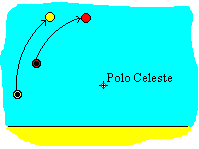 |
The celestial pole is the fixed point in the sky, and celestial objects circle this point as the time passes. In the figure to the left, we can see how two would move around a celestial pole in a couple hours. On any land position we can see only one of the celestial poles
(the same as our latitude). Looking the sky in the South hemisphere,
you will see the south celestial pole to the south, with altitude
equal to your latitude (ex: if you are to a 35°S latitude for
example, the Celestial South Pole you will be to the South, with
altitude 35°) |
|
A well known constellation in the south is the Southern Cross. Forming an alignment with Gacrux are two bright stars of the near constellation of Centaurus: Hadar and Rigil Kent.
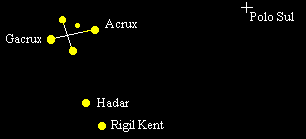
These stars are very good for the navigation in the Southern hemisphere, because they are almost always visible. Another group of stars easy to identify is Orion (the hunter). Orion is situated on the Celestial Equator, being visible from practically all the Earth, in the beginning and end of the year. Orion has a distinct simetric shape. In its center is the so called Orion Belt - a group of 3 aligned stars. Some say the positions of the three piramids in Egypt mimics this group of stars. The center star is called Alnilam. Other Orion stars are Rigel, Betelgeuse and Bellatrix. Betelgeuse is a red supergiant. Its diameter is 300 times larger then the Sun and it is 400 light years from us. Its brightness is variable. It has red color because the surface temperature is relatively low (about 3000°K). Rigel, the another bright star of Orion, has white-bluish color. Rigel is a double star. Its friend, however, can only be seen with a telescope. In the constellation Canis Major is Sirius, the brightest star in the sky. The great brightness of Sirius is due to the fact of it emits 20 times more light that the Sun and is relatively near (about 9 light years. In fact, Sirius is two times brighter than the second star, Canopus. Sirius has white color.
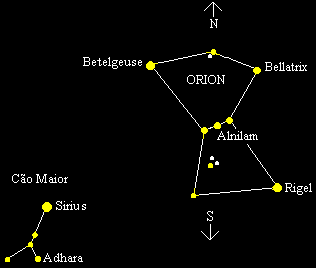
Scorpion is also a constellation with peculiar format and easy to recognize. It is located in the south hemisphere. Antares is the bright star of this constellation, with distinct red coloration. Shaula is in the other extremity of the scorpion.
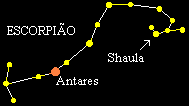
One northern constellation very easy to find is Ursa Major. This constellation, with stars of average brightness (second magnitude) looks like a pan. Alioth and Dubhe are two stars which can be used for celestial navigation. The alignment of Dubhe and Merak points to Polaris, next to the north celestial pole.
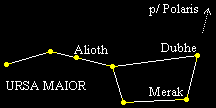
Another constellation on Northern hemisphere is Cygnus, the Swan. Despite the name, Swan is better described as a cross and is also known as the Northern Cross . Deneb and Albireo are stars of this constellation.
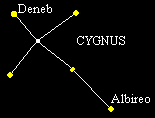
Click here to go to the on line Star Finder.
|
ęCopr 92-2012 Omar F. Reis - All rights reserved